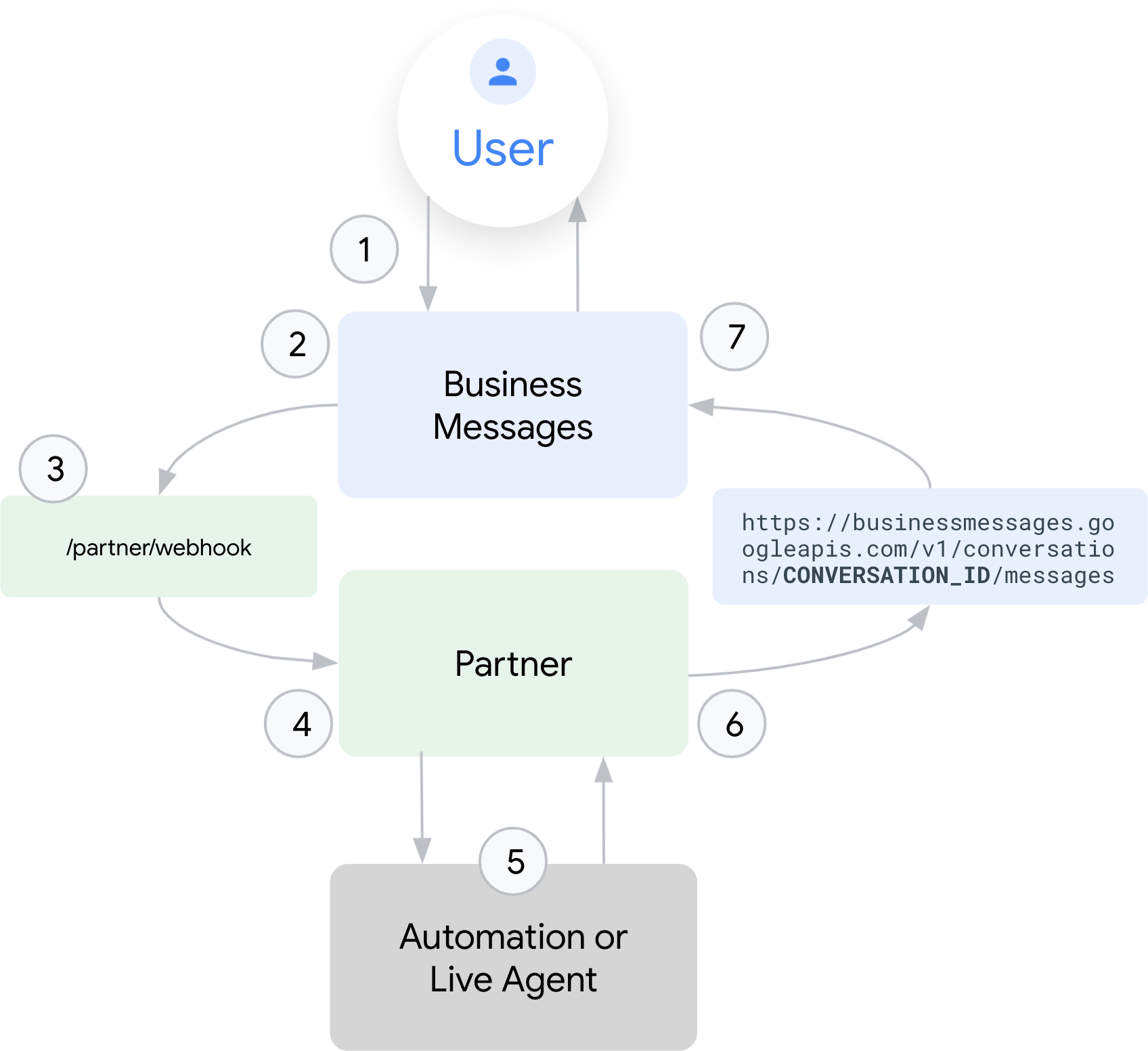उपयोगकर्ता, एजेंट को मैसेज भेज सकते हैं और एजेंट, उपयोगकर्ताओं को मैसेज भेज सकते हैं. हालांकि, एजेंट के पास इससे ज़्यादा मैसेज होते हैं. हर मैसेज में, कई पक्ष शामिल हो सकते हैं:
- उपयोगकर्ता, Search, Maps, और ब्रैंड मैनेज किए गए लिंक और वेबसाइट में एंट्री पॉइंट की मदद से, एजेंट के साथ बातचीत शुरू करता है. उपयोगकर्ताओं को किसी Google खाते में साइन इन करना होगा, लेकिन पार्टनर के साथ सिर्फ़ उपयोगकर्ता का नाम शेयर किया जाता है. उपयोगकर्ता के मैसेज, TLS से एन्क्रिप्ट (सुरक्षित) किए जाते हैं.
Business Messages, उपयोगकर्ता और पार्टनर के बीच लेयर के तौर पर काम करता है, ताकि उपयोगकर्ता की निजता को सुरक्षित रखा जा सके. इस लेयर से उपयोगकर्ता के Google खाते की जानकारी, पार्टनर या लाइव एजेंट के साथ शेयर नहीं होती. यह जानकारी, हर इनबाउंड मैसेज और आउटबाउंड मैसेज को डिक्रिप्ट करके फिर से एन्क्रिप्ट (सुरक्षित) करके, उपयोगकर्ता के Google खाते को बातचीत के आईडी से मैप की जाती है.
Google, एन्क्रिप्ट (सुरक्षित) किए गए मैसेज स्टोर करता है, ताकि उपयोगकर्ता के डिवाइस पर डिलीवरी और सिंक होने की सुविधा ठीक से काम कर सके. सेव किए गए इन मैसेज को किसी तीसरे पक्ष के साथ शेयर नहीं किया जा सकता. ऐक्सेस सिर्फ़ उपयोगकर्ता के Google आईडी के साथ उपलब्ध है.
एजेंट किसी ब्रैंड का प्रतिनिधित्व करता है, जैसा कि किसी पार्टनर ने बनाया और मैनेज किया हो.
पार्टनर, किसी ब्रैंड की ओर से एजेंट को मैनेज करता है. पार्टनर को इनबाउंड वेबहुक पर इनबाउंड मैसेज मिलते हैं, इनबाउंड मैसेज को ऑटोमेशन या लाइव एजेंट के पास भेजा जाता है, ताकि जवाबों को लिखा जा सके. इसके अलावा, उन्हें आउटबाउंड मैसेज, Business Messages API पर भेजे जा सकते हैं.
ऑटोमेशन, उपयोगकर्ता के जुड़ाव के बिना उपयोगकर्ता के मैसेज मैनेज करता है.
लाइव एजेंट उपयोगकर्ताओं के ऐसे मैसेज को हैंडल करते हैं जिनमें लोगों की दिलचस्पी होती है.
हर पक्ष, बातचीत में मैसेज भेजने और पाने में अपनी भूमिका निभाता है. एंड-टू-एंड मैसेजिंग फ़्लो की शुरुआत, उपयोगकर्ता को मैसेज भेजने वाले उपयोगकर्ता से होती है. इसके बाद, उपयोगकर्ता को एजेंट का जवाब मिलता है.

- उपयोगकर्ता, बातचीत शुरू करता है और Business Messages एजेंट को मैसेज भेजता है.
- Business Messages, बातचीत को एक आईडी असाइन करता है. बातचीत आईडी, उपयोगकर्ता और एजेंट के लिए लगातार और खास होते हैं. अगर उसी उपयोगकर्ता ने किसी दूसरे एजेंट से संपर्क किया है, तो उस बातचीत का आईडी अलग होगा.
- Business Messages, एन्क्रिप्ट (सुरक्षित) किया गया मैसेज पार्टनर के वेबहुक पर भेजता है. मैसेज में बातचीत का यूनीक आईडी, एजेंट आईडी, मैसेज आईडी, और बातचीत की शुरुआत से जुड़ी जानकारी होती है.
- पार्टनर को मैसेज मिलता है और वह मैसेज मैसेज को ऑटोमेशन या लाइव एजेंट को भेजता है.
- ऑटोमेशन अपने-आप उपयोगकर्ता के मैसेज का जवाब देता है या बातचीत का ऐक्सेस रखने वाला कोई लाइव एजेंट, उपयोगकर्ता का मैसेज देखता है और उसके हिसाब से जवाब बनाता है.
- पार्टनर, Business Messages API को रिस्पॉन्स भेजता है. ईमेल भेजने वाले के तौर पर, यह मैसेज आईडी की मदद से मैसेज भेजता है.
- Business Messages, मैसेज को डिक्रिप्ट करता है और फिर से एन्क्रिप्ट (सुरक्षित) करता है. साथ ही, बातचीत के आईडी को उपयोगकर्ता के Google खाते से मैप करता है और मैसेज को उपयोगकर्ता को भेजता है.
